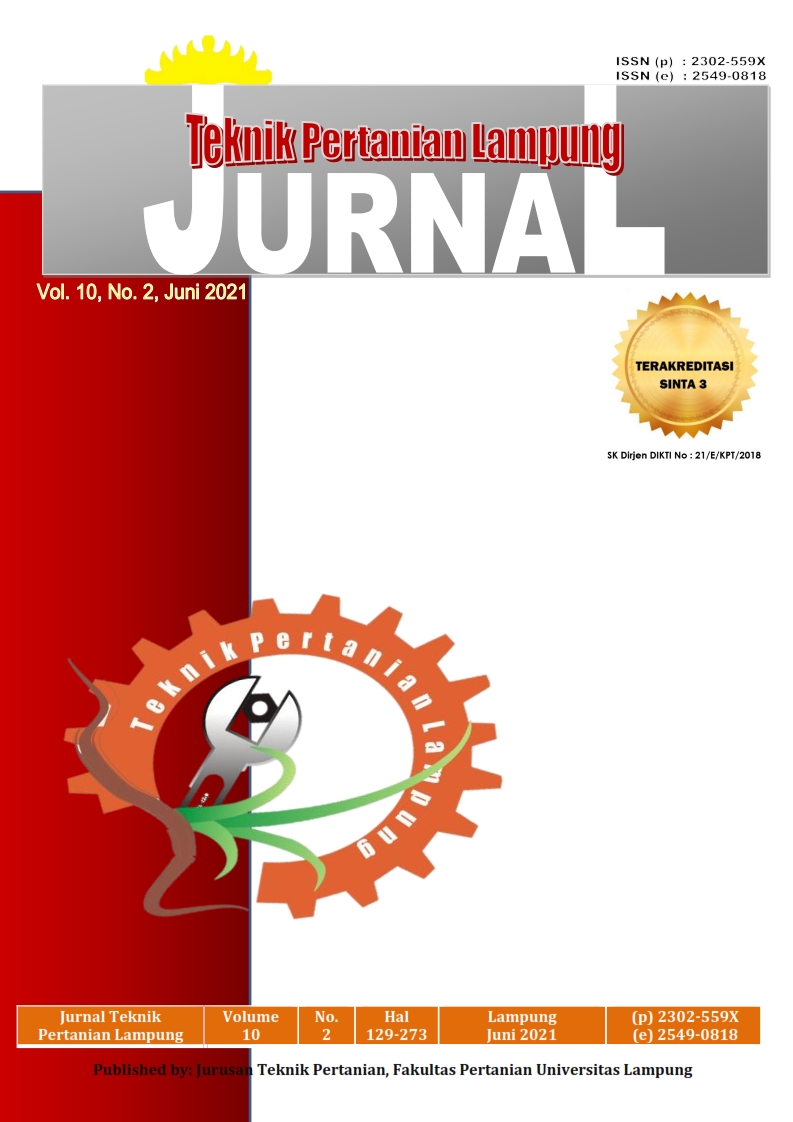ANALISIS POTENSI BRIKET BIO-ARANG SEBAGAI SUMBER ENERGI TERBARUKAN
DOI:
https://doi.org/10.23960/jtep-l.v10i2.147-154Abstract
The research aimed to examine the potential of bio-charcoal briquettes as solid fuel using a SWOT analysis approach, by comparing them with non-briquette solid fuels. The SWOT method examines internal factors (IFAS) and external factors (EFAS). The research was conducted at a wood charcoal produces located at Dumai City, Riau. Data retrieval was carried out by means of observation and interview with the owner and workers. Including production data, marketing, problems faced during production, promotion and sale, product added value, product shortages and weaknesses, competitor data and opportunities in business development. The results of this research indicated that the advantages of briquette products was renewable, cheap, raw materials environmentally friendly, ease of packaging, cleanliness in the production process and efficiency in transportation. The disadvetages was less popular, requires a combustion furnace and fluctuating heat. The ooportunity was that the need for charcoal continues to increase, especially for restaurants and micro small industry. This research was recommend the importance of public policies related to the promotion and socialization of the use of bio-charcoal briquettes as a source of clean energy that is economical and environmentally friendly.
Keywords: bio-charcoal briquettes, renewable energy, SWOT analysis
References
Alkadri, A. 2014. Analisis Nilai Tambah Dan Strategi Pengembangan Usaha Kerajinan Kepek Rotan: Studi Kasus di Desa Nusawungu Kabupaten Cilacap. [Skripsi]. Institut Pertanian Bogor.
Arni, A., Labania, H.M., & Nismayanti, A. 2014. Studi Uji Karakteristik Fisis Briket Bioarang Sebagai Sumber Energi Alternatif. Natural Science: Jurnal of Science and Technology, 3(1): 89–98.
David, F.R. 2015. Strategic Management: Concepts and Cases. Pearson Education, Inc., Upper Saddle River, New Jersey, USA.
Diretorat Jenderal EBTKE. 2021. Transisi Energi, Kementerian ESDM Jalin Kerja Sama Program Peningkatan Akses Energi Bersih dan Berkelanjutan. Siaran Pers. 8 Maret 2021. https://ebtke.esdm.go.id/post/2021/03/08/2819/transisi.energi.kementerian.esdm.jalin.kerja.sama.program.peningkatan.akses.energi.bersih.dan.berkelanjutan
Febrina, W. 2018. Potensi Sampah Organik Sebagai Bahan Baku Pembuatan Briket Bio Arang. Unitek, 11(1): 40–50.
Kalsum, U. 2016. Pembuatan Briket dari Campuran Limbah Tongkol Jagung, Kulit Durian dan Serbuk Gergaji Menggunakan Perekat Tapioka. Distilasi, 1(1): 42–50.
Miharja, M. 2016. Analisis proksimat potensi briket bioarang sebagai energi alternatif di desa kusu, Maluku Utara. Jurnal Techno, 5(1): 15–21.
Pearce, J.A & Robinson, R. 2008. Manajemen stretegis: Formulai, Implementasi, dan Pengendalian. Edisi kesepuluh. PT Salemba Empat, Jakarta.
Putri, E.R., & Andasuryani, A. 2017. Studi Mutu Briket Arang Dengan Bahan Baku Limbah Biomassa. Jurnal Teknologi Pertanian Andalas, 21(2): 143-151. https://doi.org/10.25077/jtpa.21.2.143-151.2017
Santosa, Mislaini, R., & Anugrah, S.P. 2010. Studi Variasi Komposisi Bahan Penyusun Briket Dari Kotoran Sapi Dan Limbah Pertanian. Jurnal Teknik Pertanian, 1–26.
Surest, A. H., & Afif, H. 2011. Pembuatan Briket Arang dari Serbuk Gergaji Kayu dan Tempurung Kelapa Dengan Proses Karbonisasi. Jurnal Teknik Kimia, 17(8): 29–40.
Thaheer, H., Hasibuan, S., & Ma’ruf, A. 2011. Kajian Strategi Pengembangan Investasi Energi Alternatif Di Indonesia. Warta Kebijakan Iptek & Manajemen Litbang, 9(1): 41–58.
Downloads
Published
Issue
Section
License
- Authors who publish with this journal agree to the following terms:
- Authors retain copyright and grant the journal right of first publication with the work simultaneously licensed under a Creative Commons Attribution-ShareAlike 4.0 International Lice that allows others to share the work with an acknowledgement of the work's authorship and initial publication in this journal.
- Authors are able to enter into separate, additional contractual arrangements for the non-exclusive distribution of the journal's published version of the work (e.g., post it to an institutional repository or publish it in a book), with an acknowledgement of its initial publication in this journal.
- Authors are permitted and encouraged to post their work online (e.g., in institutional repositories or on their website) prior to and during the submission process, as it can lead to productive exchanges, as well as earlier and greater citation of published work (See The Effect of Open Access).
Jurnal Teknik Pertanian Lampung

JTEPL is licensed under a Creative Commons Attribution-ShareAlike 4.0 International License.

